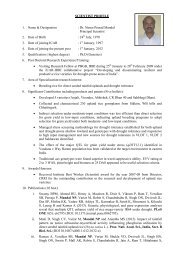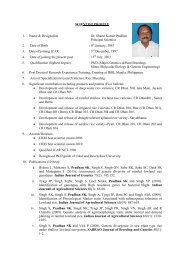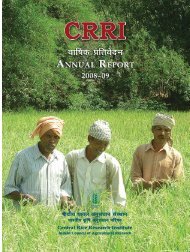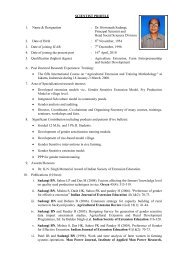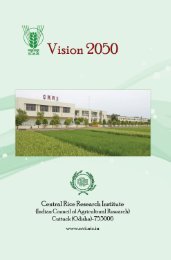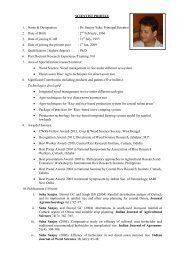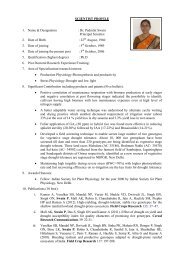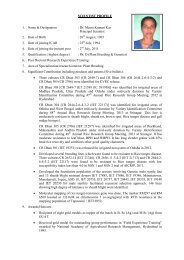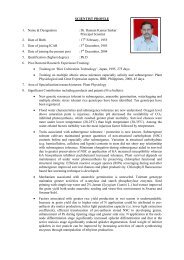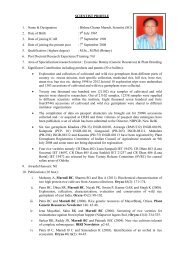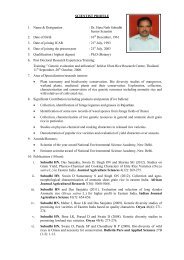Central Rice Research Institute Annual report...2011-12
Central Rice Research Institute Annual report...2011-12
Central Rice Research Institute Annual report...2011-12
You also want an ePaper? Increase the reach of your titles
YUMPU automatically turns print PDFs into web optimized ePapers that Google loves.
Enhancing and Sustaining the Productivity of <strong>Rice</strong> Based Farming Systems<br />
replications. The crop was established by spot seeding<br />
with pre-germinated seeds at 15 cm x 15 cm spacing<br />
during second week of January. Experimental results<br />
revealed that the highest yield (5.78 t ha -1 ) was recorded<br />
in the treatments where rice + Azolla dual cropping was<br />
practiced with a fertilizer dose of 90:60:60 kg N, P 2<br />
O 5<br />
and K 2<br />
O ha -1 along with Azolla (1 t ha -1 ) applied <strong>12</strong><br />
days after transplanting (DAT). However, it was comparable<br />
(5.67 t ha -1 ) with Azolla (1 t ha -1 ) + 70:50:50 kg<br />
N, P 2<br />
O 5<br />
and K 2<br />
O ha -1 . About <strong>12</strong>1% yield enhancement<br />
was recorded in Azolla + 90:60:60 N, P 2<br />
O 5<br />
and K 2<br />
O kg<br />
ha -1 over control plots where no fertilizer was applied.<br />
The benefit : cost (B:C) ratio was higher in the treatments<br />
where chemical fertilizer was applied than the<br />
rice +Azolla dual cropping.<br />
Another field experiment was conducted to evaluate<br />
the efficiency of different weed control practices in<br />
wet direct-sown rice. The treatments consisted of different<br />
herbicides viz., Pretilachlor + Safener (800 g ha -1 ),<br />
Pyrazosulfuron ethyl (20 g ha -1 ), bensulfuron methyl<br />
(60 g ha -1 ), Almix (metasulfuron methyl + Chlorimuron<br />
ethyl at 4 g ha -1 ), Almix + Pretilachlor (4+450 g ha -1 )<br />
and bensulfuron methyl + Pretilachlor (50+450 g ha -1 ).<br />
These treatments were compared with mechanical<br />
weeding (finger weeder) + hand weeding; hand weeding<br />
twice (20 and 40 days after sowing) as recommended<br />
practice, weed free and weedy check. The major<br />
weed flora in weedy plots at 45 days after<br />
sowing(DAS) were Cyperus difformis, Sphenoclea<br />
zeylanica, Leptochloa chinensis and Marsilea quadrifolia.<br />
Grassy weeds constituted 26%, sedges 45% and broad<br />
leaf weeds 29% of the total weed population at this<br />
stage. Tank-mix application of bensulfuron methyl+<br />
pretilachlor (applied as post-emergent 18 DAS at 50 +<br />
450 g a.i.ha -1 ) was found to be most effective for controlling<br />
the predominant weeds (WCE 91%) and produced<br />
comparable yield (5.67 t ha -1 ) with hand weeding twice<br />
(5.77 t ha -1 ). The highest net return (Rs. 21,298 ha -1 ) and<br />
B:C ratio of 2.30 was also recorded with the treatment<br />
of bensulfuron methyl+ pretilachlor. There was more<br />
than 43% reduction in the grain yield of rice due to<br />
competition with weeds in weedy plots.<br />
Cropping system analysis for Eastern India<br />
using remote sensing and GIS<br />
Prediction of rainfall surfaces from point data is<br />
necessary for generating alternate rice based cropping<br />
pattern maps. Deterministic interpolation techniques<br />
create surfaces from measured points, based on either<br />
the extent of similarity or the degree of smoothing. In<br />
Fig. 26. South-west monsoon rainfall spatial map of<br />
Ganjam district of Odisha<br />
this study, geo-statistical interpolation methods were<br />
used to estimate monthly (June-December), seasonal<br />
(South-West and North-East Monsoon seasons) and<br />
annual rainfalls of Odisha. Historical daily rainfall data<br />
(1982 - 2008) were collected from 168 rain gauge stations<br />
of Odisha for the preparation of spatial rainfall<br />
maps.The spatial rainfall maps were generated using<br />
ordinary kriging method and the Ganjam district spatial<br />
map of South West Monsoon (SWM) rainfall is presented<br />
in Fig. 26.<br />
Evaluation of site specific management in rice<br />
and rice based cropping system<br />
Yield spatial variability study was conducted during<br />
the dry and wet season in 4.8 acres of land in CRRI<br />
farm. The site was marked by difference in gradient<br />
with variable level of standing water due to rain (10 cm<br />
to 30 cm). The rice-rice system was followed with variety<br />
“Naveen” during dry and “Gayatri” during wet<br />
season. The yield was recorded in the grids size of 20 m<br />
x 20 m (total 48 grids), during the dry season the rice<br />
CRRI ANNUAL REPORT 2011-<strong>12</strong><br />
71



